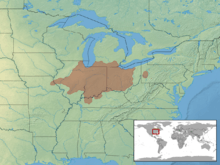Kirtland's snake
| Kirtland's snake | |
|---|---|
 | |
| Kirtland's snake, Clonophis kirtlandii | |
| Scientific classification | |
| Kingdom: | Animalia |
| Phylum: | Chordata |
| Class: | Reptilia |
| Order: | Squamata |
| Suborder: | Serpentes |
| Family: | Colubridae |
| Genus: | Clonophis |
| Species: | C. C. kirtlandii |
| Binomial name | |
| Clonophis C. kirtlandii (Kennicott, 1856) | |
 | |
| Synonyms | |
| |
Kirtland's snake (Clonophis kirtlandii ) is an endangered North American species of nonvenomous snake of the subfamily Natricinae, of the family Colubridae.[1] It is the only species in the genus Clonophis.[2]
Etymology
The specific name, kirtlandii, is in honor of Dr. Jared Potter Kirtland, an American naturalist of the Nineteenth Century.[3][4] The snake was first identified by Robert Kennicott in 1855. Kennicott sent a specimen to Spencer Fullerton Baird, the assistant secretary of the Smithsonian Institution, who offered to publish a description of the animal in Kennicott's name. Baird suggested Regina kirtlandii as a scientific name, as Kirtland had been a mentor to Kennicott.[5]
Common names
Common names for this species include: Cora Kennicott's snake, Kirtland's red snake, Kirtland's water snake, little red snake, Ohio Valley water snake, and spread head.[6]
Description
Kirtland's snake is small and slender. Adults reach a total length (body + tail) of 12-18 inches (30–46 cm). They are grayish brown with a series of large black spots and alternating smaller spots running down each side of the back.[7] The ventral scales are brick red with a prominent round black spot at each outer end.[8] It has 19 rows of keeled dorsal scales at midbody, and the anal plate is divided.[9]
Geographic range
This species is found in Illinois, Indiana, Ohio, southern Michigan, northern Kentucky, and western Pennsylvania.[8]
Habitat
Clonophis kirtlandii inhabits prairie or prairie-like areas. It is usually found not far from a water source, even though it is less aquatic than water snakes of the genus Nerodia which share its geographic range.[6]
Conservation status
The species is listed as endangered in Indiana,[10] Michigan, and Pennsylvania;[11] it is listed as threatened in Illinois and Ohio.
Diet
Kirtland's snake feeds on earthworms, slugs, minnows, salamanders, frogs and toads.[6]
Defensive behavior
When alarmed this snake flattens its entire body to a remarkable thinness, and becomes rigid.[12]
Reproduction
Kirtland's snake is ovoviviparous. Females give birth in August and September. Brood size varies from 4 to 22. Each newborn is 13–17 cm (5-6¾ in.) in total length and averages 1.4 gm in weight.[6]
Further reading
- Behler, J.L., and F.W. King. 1979. The Audubon Society Field Guide to North American Reptiles and Amphibians. New York: Alfred A. Knopf. 743 pp. ISBN 0-394-50824-6. ("Clonophis kirtlandi [sic]", p. 596 + Plate 551).
- Kennicott, R. 1856. Description of a new Snake from Illinois. Proc. Acad. Nat. Sci. Philadelphia 8: 95-96. (Regina kirtlandii ).
References
- ↑ The Reptile Database. www.reptile-database.org.
- ↑ ITIS (Integrated Taxonomic Information System). www.itis.gov.
- ↑ Beltz, Ellin. 2006. Scientific and Common Names of the Reptiles and Amphibians of North America - Explained. ebeltz.net/herps/biogappx.html#K.
- ↑ Beolens, Bo; Michael Watkins; Michael Grayson. 2011. The Eponym Dictionary of Reptiles. Baltimore: Johns Hopkins University Press. xiii + 296 pp. ISBN 978-1-4214-0135-5. (Clonophis kirtlandi, p. 142).
- ↑ Vasile, Ronald S. (Autumn 1994). "The Early Career of Robert Kennicott, Illinois' Pioneering Naturalist". Illinois Historical Journal. 87 (3): 165. JSTOR 40192718. (Subscription required (help)).
- 1 2 3 4 Wright, A.H., and A.A. Wright. 1957. Handbook of Snakes of the United States and Canada. Ithaca and London: Comstock. 1,105 pp. (in 2 volumes) (Natrix kirtlandi, pp. 496-499, Figure 146 + Map 40 on p. 491).
- ↑ Boulenger, G.A. 1893. Catalogue of the Snakes in the British Museum (Natural History). Volume I., Containing the Families ... Colubridæ Aglyphæ, part. London: Trustees of the British Museum (Natural History). (Taylor and Francis, printers). xiii + 448 pp. + Plates I.- XXVIII. (Ischnognathus kirtlandii, p. 286).
- 1 2 Conant, R. 1975. A Field Guide to Reptiles and Amphibians of Eastern and Central North America, Second Edition. Boston: Houghton Mifflin. xviii + 429 pp.
ISBN 0-395-19979-4 (hardcover), ISBN 0-395-19977-8 (paperback). (Natrix kirtlandi, p. 151 + Plate 22 + Map 106). - ↑ Smith, H.M., and E.D. Brodie, Jr. 1982. Reptiles of North America: A Guide to Field Identification. New York: Golden Press. 240 pp. ISBN 0-307-13666-3.
(Clonophis kirtlandi, pp. 156-157). - ↑ Indiana Legislative Services Agency (2011), "312 IAC 9-5-4: Endangered species of reptiles and amphibians", Indiana Administrative Code, retrieved 28 Apr 2012.
- ↑ Pennsylvania Fish & Boat Commission.
- ↑ Schmidt, K.P., and D.D. Davis. 1941. Field Book of Snakes of the United States and Canada. New York: G.P. Putnam's Sons. 365 pp. (Natrix kirtlandii, pp. 209-210 + Plate 22, Center, on p. 342).
External links
- Michigan state Department of Natural Resources entry
- The Center for Reptile and Amphibian Conservation and Management entry
